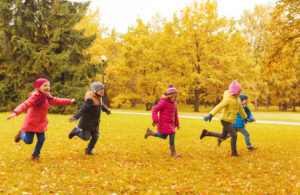By Ted McEnroe, Director of Research and Training, The Community Roundtable
 My 5-year-old daughter likes games. She also likes creating games.
My 5-year-old daughter likes games. She also likes creating games.
Last night, she wanted to come up with a game of tag. When I was young, there was tag – and if you wanted to be innovative, freeze tag. Today, my daughter’s class has category tag, turtle tag, and about 30 other varieties of tag that give me hope that the next generation won’t be completely absorbed by screens.
So we “invented” spider tag.
It’s basically freeze tag, where if you get tagged, you’ve been bitten by a spider. To stay in the game another player, while avoiding being tagged themselves, needs to come save you before you count to 10 – at which point the spider’s venom has coursed through you and you’re out.
My daughter was excited to teach her friends this version of tag – and as she thought out how to do it, she created what seems to me to be a solid strategy for building a new community:
- She started with shared value. Unlike too many communities, she could state why she was introducing the game. “To have fun.” How many of us can explain our community’s value, to both members and our organizations, as concisely?
- She kept the rules simple. Tag. Freeze. Count to 10. Saved or out. In a playground situation, you have to, right? Try to find a 5-year-old who will sit and absorb a 15-minute rules presentation before they get started doing something. Actually, let’s just save time and find a unicorn. It’s easier.
- She developed a rollout strategy. Recess time is precious, and trying to teach a new game and play it simply would be too hard. So she planned to find a few classmates to explain it to before school started, and they could try it out.
- She is starting small. I admit I suggested this one. By starting with a small group of close friends, explaining the rules to them and testing it out – she creates an opportunity to perhaps tweak the rules and get commitment from friends on the behavior that the larger group can follow later.
- She addressed her target members intrinsic and extrinsic motivators. How do you motivate a 5-year-old? Create fun, friendly, active competition with shifting alliances in an environment that encourages self-expression. Check.
- She didn’t “launch” the game. She didn’t decide that the best way to share her game idea was to wait for the next assembly, ask the school principal for 10 minutes of the agenda, and put together a Powerpoint on the Spider Tag opportunity, with a goal of getting 50% of the student market to play over the next six months. She just wants to play and let things happen more organically.
As adults, we need validators that these rules work – our research has consistently shown these practices drive successful community launches. But to my daughter, it just came naturally.
Communities are complex networks of interactions – and sometimes we let the complexity, the myriad goals, opportunities and motivators get the best of us in our planning. Next time you are starting your community, take a playground approach. You may find that shared value is easier to define, policies and guidelines flow more naturally, advocates get engaged, members get motivated, and growth naturally follows.
You may even have fun.
